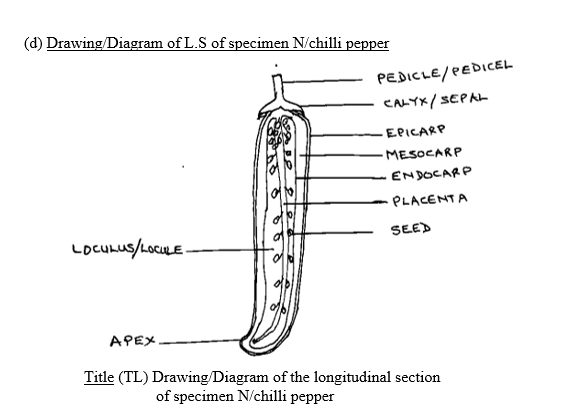QUESTION 3
Study specimens L, M, and N and answer questions 3(a) to 3(f):
- Classify each of specimens L, M and N based on:
- type of fruit;
- life cycle. [6 marks]
- Make a longitudinal section of specimen L, and state four observable differences between specimens.
- L and M; [4 marks]
- L and N. [4 marks]
- State three observable similarities between specimens L and N. [3 marks]
- Make a drawing, 8 cm – 10 cm long of specimen N and label fully. [10 marks]
- Name the:
- mode of dispersal of specimen L; [1 mark]
- placentation of specimen L. [1 mark]
- State one economic importance of specimen N. [1 mark]
Many candidates gave good responses to this question. They were able to state the types of fruits in 3(a)(i) and the life cycle in 3a(ii) but did not write the differences between orange and chilli pepper correctly.
Many candidates did not give observable features as required. They gave varied theoretical responses such as colour instead of differences size, number of their seeds, placentation etc.
Some candidates were able to give the mode of dispersal of specimen L/orange fruit and one economic importance of Specimen N/chilli pepper.
Many candidates lost marks because their drawings lacked technical details like thin epicarp
shown with double lines (TE), elongated end with tapering apex (TA), use of wrong
magnification and poor labelling.
The expected answers are as follows:
(a) (i) Type of fruit of Specimens L/orange fruit, M/coconut and N/chilli pepper
L: Berry/hesperidium;
M: Drupe;
N: Berry
(ii) Life cycle of specimens L, M and N
L: perennial;
M: perennial;
N: biennial/perennial.
(b) Observable structural differences between
(i) specimens L and M
L/orange fruit |
M/coconut fruit |
|
hard fibres; |
|
one seeded; |
|
stony/hard endocarp; |
|
one chamber/locule; |
|
hard to touch; |
|
big; |
|
mesocarp fibrous; |
|
basal placentation; |
|
glands absent. |
(ii) specimens L and N
L/orange fruit |
N/chilli pepper fruit |
|
succulent fibres absent; |
|
smaller seeds; |
|
more seeds; |
|
elongated; |
|
free central placentation; |
|
seeds clustered; |
|
not juicy/dry; |
|
glands absent; |
|
calyx present. |
(c) Observable similarities between specimens L and N
Both possess
- seeds;
- two scars;
- pericarp/ (epicarp, mesocarp and endocarp);
- attractive colours;
- placenta.

-
Quality (Q)
Clarity of lines (CL)
Size (SZ) (8 cm to 10 cm)
Neatness of labels (NL) All guidelines ruled;
All labels horizontal
Magnification (MG) (× /×0.5 to ×1)
/×0.5 to ×1)
Details (D)
Thin epicarp shown with double lines (TE)
At least two seeds shown (TS)
Elongated end with tapering apex (TA)Labels (L)
Epicarp, pericarp, mesocarp, endocarp, seed(s), scar, placenta, loculus/locules, apex, calyx/sepal, pedicle/pedicel.(e) (i) Mode of dispersal of specimen L/Orange fruit
Animal/Man.(ii) Placentation of specimen L/Orange fruit
Axile.(f) Economic importance of specimen N/chilli pepper
- Used for cooking/used as spice;
- Source of food;
- For medicinal purposes;
- Source of income.
